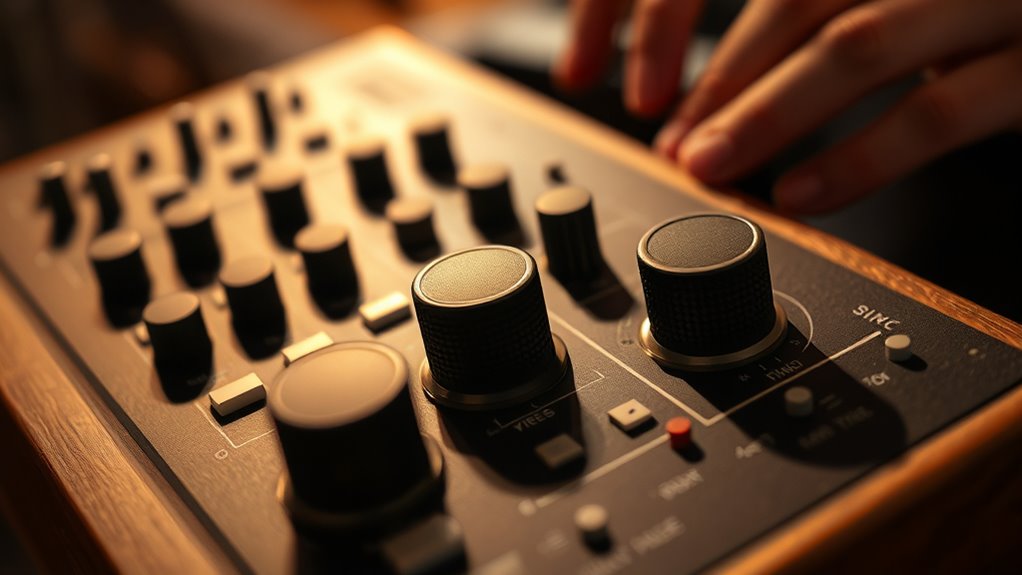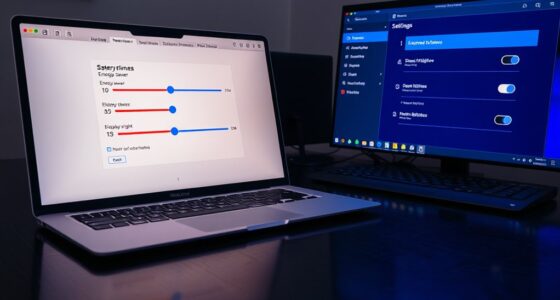To preserve feel while quantizing, avoid strict settings and opt for partial or loose quantization by lowering the strength to about 50-70%. Use subtle swing settings to add a natural groove, and manually nudge individual notes where needed for extra rhythmic feel. Combining these techniques helps you tighten your groove without sacrificing human expression. Keep experimenting with these adjustments, and you’ll discover how to craft rhythms that sound both precise and lively.
Key Takeaways
- Use partial or loose quantization with lower strength settings (50-70%) to retain natural timing nuances.
- Apply subtle swing or shuffle settings to add groove without making rhythms overly rigid.
- Combine quantize with manual adjustments to fine-tune timing and preserve expressive feel.
- Select appropriate preset swing/shuffle options and customize amount for the desired groove style.
- Avoid strict, fully quantized settings; prioritize natural human timing for a lively, organic sound.

Quantize settings are essential tools in music production that help you align your notes and rhythms to a specific grid, ensuring your timing is precise. However, rigidly quantizing every note can make your music sound mechanical and lifeless. To maintain a natural feel, especially when working with swing or groove, you need to adjust your quantize settings thoughtfully. Swing feel, in particular, relies on subtle timing variations that give your music a relaxed, human touch. Applying strict, straight quantization can eliminate these nuances, making your groove sound stiff and robotic. Instead, focus on settings that preserve the natural swing rhythm, allowing your groove to breathe and flow organically.
Rigid quantization can make your groove sound stiff; use swing and partial settings to keep it natural and lively.
To keep groove consistency while quantizing, start by selecting a swing or shuffle setting that matches your desired feel. Many digital audio workstations (DAWs) offer swing options that shift the timing of off-beats, creating a laid-back or energetic groove depending on the amount of swing applied. Use these presets as a foundation, then fine-tune the swing amount to match the style you’re aiming for. It’s important to listen carefully to how these adjustments influence the overall feel. Too much swing can distort the rhythm, making it feel uneven, while too little can make it sound stiff. Striking the right balance ensures your groove remains tight yet relaxed.
Another technique is to use partial or loose quantization. Instead of snapping notes directly to the grid, set your quantize to a lower strength—say 50% or 70%. This way, notes move closer to the grid but retain some of their original timing, preserving the human feel. When you do this, you maintain groove consistency because the subtle timing imperfections stay intact, giving your track a natural swing. Experiment with different quantize strengths and timings until you find a setting that enhances rhythm without sacrificing groove. Remember, the goal isn’t perfection but maintaining a lively, human feel.
Additionally, selecting quantize settings that are inspired by real-world performances can help in maintaining authenticity. By emulating natural timing variations, you can preserve a more organic groove while still achieving precise timing. Lastly, it’s helpful to manually adjust specific notes after quantizing. Automated tools can get you close, but a little human touch ensures your rhythm stays lively. Listen for sections where the groove feels off or too rigid, and nudge those notes slightly ahead or behind the grid. This small adjustment can dramatically improve the overall feel, especially in genres like jazz, funk, or swing. Using a combination of swing settings, partial quantization, and manual editing allows you to achieve precise timing while still preserving that essential groove consistency. With practice, you’ll develop an ear for balancing quantization and feel, making your tracks sound both tight and naturally expressive.
Frequently Asked Questions
How Do I Choose the Right Quantize Grid for My Genre?
To choose the right quantize grid for your genre, start by analyzing your groove and feel. For genres like jazz or funk, opt for a swing adjustment to add groove consistency, making the timing feel more natural. If you’re working on straight rhythms like pop or EDM, choose a tighter grid for precision. Experiment with different swing and grid settings until the quantize enhances your track without sacrificing its feel.
Can Quantize Settings Affect the Emotional Feel of a Track?
Did you know that tight quantize settings can boost a track’s emotional impact? Yes, they can, by affecting groove preservation. When you choose the right settings, you maintain natural feel and subtle human nuances, ensuring the music still resonates emotionally. Using subtle quantization preserves the groove’s authenticity, making your track more expressive. So, experiment with gentle settings to enhance emotion without sacrificing the organic feel that connects listeners to your music.
What Are Common Mistakes When Adjusting Quantize Parameters?
When adjusting quantize parameters, you often fall into timing pitfalls like overquantization, which can make your track sound robotic and lose its groove. A common mistake is setting the quantize strength too high, stripping away natural feel. Instead, experiment with softer quantization or partial settings to maintain human feel. Always listen carefully to make certain you’re enhancing rhythm without sacrificing the groove that gives your track its energy.
How Does Humanization Differ From Traditional Quantization?
Humanization differs from traditional quantization because it uses humanization techniques to add subtle variations, making your music feel more natural. Instead of rigidly aligning notes to grid lines, you adjust timing and velocity to replicate emotional timing, capturing the nuances of a live performance. This approach preserves the groove and feel, preventing your track from sounding mechanical and allowing listeners to connect more deeply with your music.
Are There Specific Plugins That Help Preserve Feel During Quantization?
Absolutely, you can keep the groove alive with plugins like quantize tools that use groove templates and swing presets. These tools act like a heartbeat, subtly nudging your timing to preserve the natural feel. Plugins such as Ableton’s Groove Pool, FL Studio’s Quantize Panel, or Logic’s Flex Time let you apply these presets effortlessly, ensuring your rhythm stays lively without sacrificing precision. They’re your secret weapon for groove preservation.
Conclusion
By fine-tuning your quantize settings, you craft a rhythmic landscape that feels natural yet precise. Imagine your beats flowing like a gentle stream, each note landing softly yet intentionally, preserving the groove’s soul. When you embrace subtle adjustments, you create a musical tapestry that resonates deeply, like sunlight filtering through leaves. Keep experimenting, and let your settings breathe life into every pulse, ensuring your feel remains intact amidst the digital precision.










